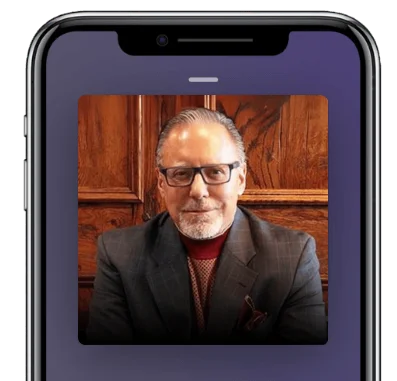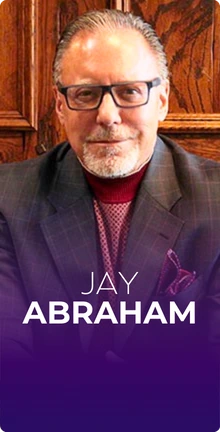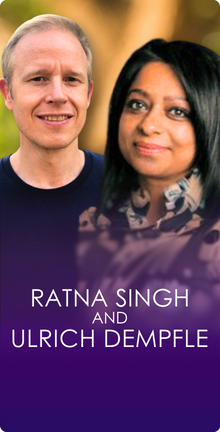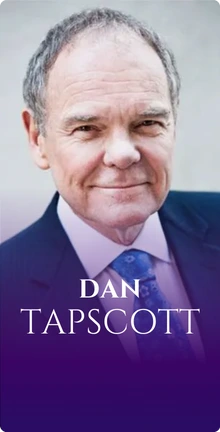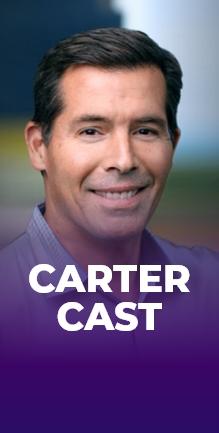In this Episode
- [00:40]Stephan introduces Jay Abraham, the world’s preeminent business growth expert. He is a business executive, conference speaker, and author known for his work in developing strategies for direct-response marketing.
- [07:13]Stephan and Jay talk about the contents of Jay’s book, Stealth Marketing: Recession Proofing Your Business.
- [15:14]Jay explains the strategy of preeminence and how it can enhance the quality of an entrepreneur’s life.
- [21:49]What is an example of a preeminent entrepreneur?
- [28:41]Jay talks about the concept of the Power Parthenon.
- [36:04]Jay shares the inspiration behind calling it the Power Parthenon.
- [43:18]What are the three ways to grow a business?
- [54:08]Jay describes what his $25,000 business growth event looks like and his 90-minute program that helped entrepreneurs make a breakthrough.
- [58:53]Jay elaborates on how he grows in humility as he gets older with experts he collaborates with.
- [62:42]Visit Jay Abraham’s website at abraham.com to learn more about increasing business income, wealth, and success.
Welcome Jay, it’s so great to have you on today.
Thank you, Stephan, and that was an overly and probably an under deserved introduction but it certainly will make my family impressed, thank you!
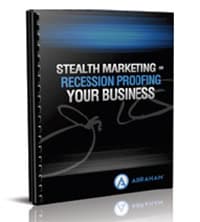
You’re so humble. So let’s talk about Recession Proofing Your Business book. That was $1000, and at the time, one of the most expensive books available. Tell us about that strategy that certainly set you apart from those other books that were $10-$20. Including the limited print run, it added exclusivity and scarcity to the equation, so it made it even more valuable and made people clamor for it. Can you just walk us through the evolution of that strategy to come up with a $1000 book?
Sure! You have to understand that nothing meaningful can be – it is all about value and value that is real. And what is real value? I had a history of previously operating privately with entrepreneurial companies and making very big in-roads for them in the bad economic environment. I looked at all the things I had done for a multitude of diverse clients, and we distilled the most important universal issues, challenges, actions, strategies, pre-emptive strategies, cost-reduction, revenue enhancement, sourcing opportunities – and we distilled it into a one-of-a-kind, truly manual book to address the top 50 questions you are probably struggling with and give you clear-cut actionable and executable answers. The top 50 questions and answers and how to masterfully deal with them. The top 50 opportunities that most struggling, besieged, or stuck entrepreneurs couldn’t see on. And things that you wouldn’t think to ask but need to know. And we put it together with clear-cut actionable instructions.
As you said, it was the quintessential distillation of the actual advice, expertise, and more importantly, empirically validated results that I engineered for real-life operating businesses for a multitude of categories. We sold the book, not on that, but what the strategies had produced for all the clients I helped. We contrasted it with “it’s one thing to give you a bunch of stratagems that people aren’t really using” – these were taken from literally yesterday, last week, last month from an environment that was absolutely the same, and these were working in this industry and that industry and that industry and it basically – we depicted me, it is like getting a $50,000-day expert and you’re getting him to come in – and the distillation of about 100 days of expertise. Are we saying this is 100 times 50, or 5 million dollars? Of course not. A $1000, since you can’t get anyone who’s got more than a few industry experience for that price, it is way and well above anything comparable. More importantly, we don’t even have to sell you on it. We don’t consider your purchase complete until you’ve had it, you’ve reviewed it, you’ve picked as many elements and applied it. Test drive it for 45 days. We gave them a denominated minimum performance, like 10-1 or 20-1. They had to get that in the first 45 days, or we wouldn’t even consider letting them keep it, and it did very well.
It is a prime example of risk reversal. It wasn’t just, “I’m buying a book, I may never read it, it may just sit on a shelf”, this was the distillation of real-world advice across all different industries. It is an alternative to hiring and spending a magnitude more money, and yet they don’t have to make an investment that has any risk involved, because you are going to get all your money back unless you make a 10-1 return on this $1000 investment.
We are saying it worked for a multitude of companies more rapidly and with less risk and more predictability than anything out there.
A lot of things I have done are embedded with a multitude of very ethical, strategic, let’s call them subliminal, components. This one was the closest equivalent for hiring a $50,000/day expert for 100 days and paying him 1%. It was all future pacing with a very interesting spin. We would take them into the future and tell them what was possible, predicated, and acknowledged as being indicators of real client experiences. And then we do a takeaway. For example, am I saying you will see how to change your copy or your media and in one shift double the results while everyone else receives half like X did? Maybe, maybe not. On the other hand, you could do much more, depending on the universe and we did it back and forth and back and forth. And we did it in a way that was impossible not to engage the reader or entrepreneur in an active vision of seeing his or her business performing in different ways.
You pre-empted objections in a way that engaged that prospect.
Yeah! And again, I don’t remember the exact copy, but are you promising it will work and make me a trillion? No! We are saying it worked for a multitude of companies more rapidly and with less risk and more predictability than anything out there. And the combinations give you five different elements of your business it can impact. If it doesn’t, read it, don’t do anything with it, and then send it back! If it does, you’ll be so outsized that you’ll be embarrassed, and we just wrote it that way.
And you mentioned a while ago that they really could hire you at $50,000/day for 100 days. Was that your rate at the time? $50,000/day, and is that still your rate now?
This is hilarious, but it’s true. I do 5, maybe 10 full-day counsels a year and 1 or 2 things happen. It is either the biggest waste on both sides, or the best investment. And we analyzed the two, and if you actuate the yield is outrageous, but if you don’t it is a waste. I’m more interested in a long-term, modest fee by my standards, high performance. We just raised our rate to $100,000. It can seem justified to companies that apply what I have to recommend, it can seem appalling to companies that are relegated to an attitude of contemplation, equivocation, and observation. But if you are somebody that – I’m not trying to sell consulting, but now we are $100,000/day.
You want to be the one investing in your clients first. You don't want to wait for them to invest in you. Share on XIt is definitely for action-takers because the ROI of an unimplemented strategy is 0. You also mentioned you can take part in the backend or some upside in addition to the fee.
We prefer that. When I got started, all I ever did was take 20-30% of the increased performance profit that I could generate from activities that they were already doing, additional activities I could add, replacement activities that outperform I would only get in on the delta. New products, new sources, new markets, and we made millions and millions of dollars, and we accidentally got into public education and training. My preference is to take a smaller retainer monthly and take a much higher backend and perform and produce, being vested in the outcome is infinitely more profitable, unless you are going to get a million-dollar or 2 million dollars a year fees. That’s a harder sell. It is very easy to be at risk on the same side if the client has the resources, the compatibility, the infrastructure – we always like performance.
I like performance as well, I created a technology over a decade now, it was called GravityStream, it was a pay-for-performance model for SEO. We got paid essentially on a cost-per-click basis. But instead of paid performance, this was for SEO.
That’s fabulous.
That was the big reason why my agency Netconcepts got acquired. It wasn’t the consulting revenue, it was the pay-for-performance, the cost-per-click revenue that clients like Zappos and Nordstrom were paying for.
It is wholly counter-intuitive.
Pay-for-performance, I’m a huge fan of that. Any time you can hire someone on a pay-for-performance basis, or you can charge for services or products on a pay-for-performance basis, I think it is fantastic.
My preference is to take a smaller retainer monthly and take a much higher backend and perform and produce, being vested in the outcome is infinitely more profitable.
There is only one caveat. It has got to be very high integrity, collaborative process. First, you have to be providing somebody who can perform, and secondly, you and the client have to cooperate, collaborate, report, and be fluid because you might need to change things. It is the ultimate partnership to optimize things.
Absolutely, it’s like if both parties are not highly accountable and highly intentional, it is just not going to work.
I agree.
So let’s talk about preeminence because a preeminent marketer charging $100,000/day and doing incredibly well, getting untold millions of dollars from pay-for-performance work, you have established yourself as one of the top marketers ever. You “eat your dog food” and apply your strategies of preeminence so you are positioned as the preeminent marketer.
One of my very large clients taught me – they were operating in a very competitive arena, twice as large as their closest competitor. They were charging 50% more and getting it, it was a prescription type of high-priced business. They were getting greater loyalty, renewal, ancillary sales and they were twice as profitable for the dollars for them as anybody else. I was to do one thing for them, but instead, I did a trade. I traded them half a million dollars of my time for the privilege of trying to uncover and discover and quantify what this mysterious distinction was that was driving this oversized, outsized, elevated, stratospherically superior performance and metrics.
So I went there, did my deal, and for five days I interviewed every executive, every operational person to see differentiated interpretations, similarities, and concurrencies. I had 1000 pages of notes, and I distilled it down to a basic, at least a working philosophy. It became a strategic philosophy to operate the totality of your business life, because it had a universal translation in everything you do, from your culture, your positioning, your marketing, your interaction with the continuum. It also had a profound and incomprehensible impact on enhancing the quality of an entrepreneur’s life, personal, family, everything.
It is shameful that I have not ever really developed it to its full majesty. But there are hundreds of businesses that have been impacted by it. So just let me give you the short course on it for tools for your audience. We have five hours of generic, written talking points, 2 90-minute examples of specific applications, and 2 industry scenarios that you are welcome to have and put it on your website, I’m fine with that.

That’s very generous, thank you.
So the short course. It starts with a belief system. You want to be seen in the eyes of your target market as the most trusted advisor they ever have, and it is for life. Two, you want to be seen as the only viable source they can turn to, not just as a commercial transaction, but for clarity, education, ideas, answers, contrast. Three, you want to be the one investing in them, you don’t want to wait for them to invest in you. Your premise is it is only a matter of time before the people you want to reach will do business with you. So you don’t need money to change hands to start investing value.
Number four, you have to understand clearly what value means to the different segments of markets you are addressing, and the only way you can understand that is to invest the time, effort, and true deep reflective attention to get to examine how your target audiences, and it can be different ones, see life. Not just the ultimate purchase interaction, but what motivates them, their life, their job, what their pressures are. You’ve got to be able to know it enough to express to them in words and in actions that you know how they feel. You understand what they are trying to do. You’ve got to be able to move your communication from trite rhetoric that everybody uses to verbalizing in very clear-cut language that has never been shared before with them, what is felt in their heart and their soul and what they are trying to get either accomplished, what they are trying to get solved, away from, closer to, and what they are trying to understand, and I am committed to doing it with you and for you.
If you want to be their trusted advisor, you have a moral obligation to tell them exactly what is and isn’t in their best interest.
If you want to be their trusted advisor, you have a moral obligation to tell them exactly what is and isn’t in their best interest. Parenthetically, Stephan, in business, most people want to do business, they want to generate an order. They don’t want to care as much about if the purchase is the absolute optimal or best decision for that buyer. They just want to make money. A preeminent entrepreneur only sells people what will be the very best service at the time and for the purpose. That means three things. You’ll never sell them less than you should buy. You’ll never sell them more than they should buy. You’ll never sell them fewer components than will give them the best outcome. You’ll never sell them less quality/quantity or combination of the two. You will counsel and advise them.
I’ll give you a couple of examples. If you were a bicycle store. If I went with my young five-year-old to buy him his first real bike, and I wanted to buy him a $2000 tricked out, five-speed 20-incher, and if you were preeminent, you would say “Jay, I cannot take your money until I first advise you that that bike is probably over-engineered and too expensive and too delicate and complex for your son’s first bike. I’d love to sell you a $2000 bike and make a profit, but in truth, this $750 bike is probably a better starting bike for your son. For his first year, he can beat it up, it’ll take a licking, and keep on going. I think it is a better, safer, and wiser option. Once he gets good at it, I’ll be ready to sell you this $2000, or even $3000 over here, because he will be ready. I’ll even give you credit from the bike you bought. If you want to buy the $2000 bike, I will not deny you that purchase, but I do want you to know that my strongest heartfelt recommendation for you or your client is to start here. That is being preeminent.
I get that. Right. If you’re really dealing with the best interest of the client and prospect and setting your agenda aside, it is a necessary prerequisite of being preeminent. If you’re unwilling to take the hit on your initial revenue because you built this relationship that pays orders of magnitude more over the customer’s lifetime, you’ve got a shortsighted business strategy.
Your job is to be an advisor, not just a taker of a consumer’s money. Your job is to distinguish and differentiate yourself in their eyes to have a fresh stance, not a patronizing one.Jay Abraham
And there’s more to it, and I’ll give you a couple more and then I’ll flip it. So your job is to be an advisor, not just a taker of a consumer’s money. Your job is to distinguish and differentiate yourself in their eyes to have a fresh stance, not a patronizing one. That there is a better way, that they are not getting the full story, everyone is telling the same thing – your job is to be a little bit iconoclastic and very unique in your positioning. Your job is to see yourself as an advisor and as such, give advice, not manipulation, you should educate, and you should contribute to that higher level of valuable understanding education, and training before you ever ask for money.
You should understand trust-building because there is science behind it, and you should understand fascination because there is science behind it, because those two factors enhance, solidify, and sustain and bond people higher. You should never refer to the people you sell to as customers. Because if you look at Webster’s Dictionary definition of customer, it is somebody who buys a commodity or service. By calling them that, you are blatantly saying that your business is nothing but a commodity and you’re marginalizing yourself. A client, if you refer to them as that, is someone under the care, the protection, the wellbeing, of another and it connotes another level of positioning, of a higher level of value, and a higher level of understanding and trust.
Most people in business focus all their effort and time in securing the buyer. They don't realize that is the highest expense and the hardest to do. Share on XYou need to incorporate future pacing that is authentic and take them into the future showing them how their lives, health, business, will be transformed or enhanced once they have your service at work in their lives or their businesses and the concept of at work connotes animating and making it come alive. You’ve gotta understand that people don’t buy – and that’s your opportunity to articulate it – we joke that when someone goes to the hardware store, they don’t want a drill, they want a hole. They want to be able to affix something together so they can connect something. So you can understand that. There’s a lot more to it, but that’s a starting point.
Let’s talk about the business Parthenon, that’s a concept you’ve taught over time. I first heard about it from Tony Robbins, he teaches it in Business Mastery and Business Mastery II as a really core concept. Could you walk our listeners through the business Parthenon?
If you look at the body of my life work, accidentally, I became the utmost expert in the world of performance enhancement of what I’ll call leverage marketing of optimization. And the integration of those three in simple terms is being able to get the highest and best return, use, outcome, and future with the least amount of time, effort, cost, and risk out of everything you do, every access you have, every dollar you spend, every human capital dollar you spend, I go on and on. I learned to focus on what I will call the geometry in the business.
Most people don’t know that every business has within it you can call them impact points, you can call them leverage factors that are going on continuously, sort of like atoms you don’t see that are more often than not meaningfully or grossly underperforming their potential and capacity. I started focusing on the difference between trying to start a business slowly and incrementally and trying to start a business safely but geometrically and I found to my delight that it is easier, faster, much more fun, and much more exhilarating to focus on those activities which produce geometric or exponential certain gain and results as opposed to things that are slogging along at incremental levels. That’s the big overview.
From that, I created things like the “3 Ways to Grow a Business”, the quintessential business-building stratagem that harnesses geometry and exponentially multiplied results and it is infallible if you do it. I created the Power Parthenon and let me explain it first. I’ll give you another document that is about 14 pages that demonstrates the power of exponential growth that resides in both of them. It takes one more insight into my life. Most people in industry spend most of their life in that industry – their understanding is based on what they have observed, what they’ve been taught, and what they’ve learned in a seminar or a course. But it’s limit tends to be observational, replicating, or it tends to be theoretical.
Funnel vision is the ability to distill, aggregate, and bring the best universal elements from many hundreds of industries and combine them into many elemental, universal, and simple stratagems, principles, tactics, and concepts that anybody can use and have a very very high success probability even if under executed.Jay Abraham
I have been blessed because I have frontlines of commerce and frontlines of capitalism, direct involvement in probably 800 different industries by now. I’ve gotten to see all the higher-performing, less dangerous, more profitable, more predictable, more impactful ways to change marketing, to change the positioning, to change offering, to change business models, to change sourcing. I’m just saying that because it has driven my ability to create something called funnel vision, which is the polar opposite of what most people possess, which is tunnel vision. Funnel vision is the ability to distill, aggregate, and bring the best universal elements from many hundreds of industries and combine them into many elemental, universal, and simple stratagems, principles, tactics, and concepts that anybody can use and have a very very high success probability even if under executed. That’s just a bit of a prelude.
Right, so essentially you’re making multiple income sources, maybe 6, 8, or 10 income streams to your business, which is this business Parthenon which provides more geometric returns, not just eeking away at incremental returns by doing the same old that you’ve been doing. The idea of funnel vision, not everything makes its way to the end of the funnel. This applies to product development too.
I remember way back in the day, 20 years ago, one of my first clients was the Product Development and Management Association, PDMA, and I went to one of their annual conferences and learned about product development, and it is a funnel, not a tunnel. Not every good idea should see its way to the end and end up being a product or service or marketing strategy. Lots of good ideas should be culled on the way through, even 90% of the way through development, you almost have a product, you have a prototype, and you still shelve it. That to me was an epiphany. I’m an idea guy, I come up with 100s of ideas a day, and not every idea should see its way to fruition.

Let’s take it to the beauty of the Parthenon. I created it when I was young because I jumped from one industry to the other industry to the other industry and I realized that most industries frame themselves around one major selling point, either source, or approach, and it can be salesforce, it can be direct mail, it can be trade shows, it can be reps, it can be Linkedin, whatever it is. And they grow a business that is delicately and precariously dependent on that one source. If anything happens to that one source, it can be comprised, and lots of things can go wrong. Then their whole dynamic is screwed. I know people or I’m sure you know many people who got thrown off of Amazon for reasons that were maybe undeserved but a business that they were doing stopped. I know sales organizations that rehired all the salespeople away because the owner didn’t know any of the clients and the whole business collapsed. I’ve seen people go to trade shows and the shows get less attendance and more busyness and get less yield.
The point is if you build your business on one single pillar, it is long-term a prescription for at very least danger and very most destruction. What I try to get every client I work with to do is build at least 7 additional pillars, and if you look at it graphically, it is majestic. You’ll see that it is a harder model to destroy. I call it the power Parthenon because fully built out, it looks like the Parthenon from Greece and it still exists, not in its fullness, but it has endured wars, in one war it was used as a weapons arsenal and a bunch of bombs exploded and a bunch of big shells went off, and it is still standing. You want something to endure, so that is the first thing.
If you build your business on one single pillar, it is long-term a prescription for at very least danger and very most destruction.
Then, if you look at the concept of geometry, if your main business is being driven by your one source, and you add 7 – 8 other sources, additional complementary sources, and each one added only 5 – 10% more revenue, it is not just 5 or 10. You are going to get geometric growth and get maybe 300 – 400% more revenue and higher profit because the incremental cost of most of these other pillars is low and what you can do also is the more pillars you get, the more market penetration you get. Also, the most criss-cross pollination you get, the more vantage points, which has the effect of positive Chinese water torture in moving and advancing and enhancing people to closure that maybe didn’t get pushed enough by your main side. If your main source gets compromised a little or a lot, it is a terrible imposition but it does not cause the ruination of the business, and we have about 20 different sources we would consider installing sequentially, and they are all set up as revenue profit centers. Not cost and expense approaches, but everything from major referral generation strategies, really innovative media, partnering, endorsement, doing lots of different selling strata they don’t normally do.
One of the different things I’d do at conferences is I’d come up with 100 different ways of selling and there would be people in the audience that I’d ask “whose main business is done by this?” and maybe 30 people would raise their hand. And how much business? They’d say 10 million, 5 million, 100 million. Okay, then I’d say “who doesn’t do any of this at all?” And there would be 900 people. And at the end, look. If 30 people are getting $500 million with this technique, and you’re doing nothing, do you think adding a version of it as one of your pillars, even if you only did $500,000 more, it might be worth doing? That was the genesis. It’s refined, but does that explain it?
Your job is to be an advisor, not just a taker of a consumer's money. Share on XYes, perfect. Back in the day when I started my business, my first real marketing strategy was to speak at conferences, and when the economy took a turn for the worse and I’d been speaking for many years and attendance started to wane at these conferences, and they would have fewer conferences because of the economy, had I only relied on that one pillar, I’d have been in real trouble.
A current example is webinars have been underperforming recently. The show-up rate used to be upwards of 50%. That’s turning out to be around 20% now. The idea of relying heavily on webinars for your marketing channel when people are showing up in fewer and fewer numbers – you still get the registration numbers but people aren’t showing up – you’ve got to get a different strategy going. You’ve got to get some other pillars. Key concept.
Let’s move onto another concept that Tony Robbins talks about. That is your concept. He talks about it in Business Mastery, Business Mastery II, and so forth. And that is the 3 ways to grow a business. There is increasing the number of customers, the average dollar amount per sale, or the frequency of purchase. Can you expound upon how this could become a geometric expansion for a business?
Most people in business focus all their effort and time in securing the buyer. They don’t realize that is the highest expense, the hardest to do, the biggest expenditure of trust-building energy. Everything about it is very low leverage. Once you get the client, if they have your trust, and you are preeminent about getting them to buy larger units, more things, more often, and getting them to buy more often than that, and other ancillary products and services. And it is relatively easy and those sales are as close to zero. Most people think of selling and growing more clients. We believe the first thing you do is making sure those clients you come in with become more profitable. You want to get more clients, more prospects, convert more prospects, have higher units of sales, have more combinations of sales, have more frequency or utility of sales.
People stop because they outgrow the product and if they have a great experience, they are perfect candidates for referral.
If you have additional products, you partner with people who have products that either complement or are continuations, or are the kind of products that would be purchased before, during, or after they buy your product or service. We have a very simple model and it won’t be quite as profound. We take a hypothetical business that is doing 1000 clients. They are doing about a $100 average unit of sale, and they have about two average purchases per year per client. Even with all these cheap and free tools, almost nobody knows what their metrics are. But if you have a company doing a 1000 clients, $100 a sale, 2 sales a year, that’s $200,000, right? So what would happen if you only increase each of those figures by 10%? Took $100 sale and turned it into a $110 percent. Took 2 sales and turned it into 2.1. Everybody thinks it is going to be 10% but that is where the geometry comes in. It is around a third. If you increase clients by 25%, and average sales by 50% and frequency by a third, I believe, I don’t have the exact numbers, that is about 400% increase in sales and a massive increase in your profit margins because the costs are very fixed and it is only marginal incremental. If you doubled those numbers and took those numbers and took 1000 to 2000, $100 to $200, and 2 to 4, it would be 800%, but that is just a simple example of working on the geometry of the business.
That is what I get everybody to do. Within each of those categories, there are about 30 ways to do it. But the simplest thing, to give you an example, there are very few people whose marketing can’t be improved, whose headline can’t be made 20-30% better, whose conversion system can’t be made if not infinitely better, made better. As I’ve said, I did a dissertation, we analyzed 50 impact points that nobody even recognized could be enhanced. There is almost nobody that keeps track of their inactive clients. There are four reasons you lose clients. One is they had an interruption in their life that had nothing to do with you and they got addicted to not coming back. If you contact them with the right message you can get 40% to start buying again. The second is that they had a bad experience, maybe the delivery was wrong, maybe a person oogled their wife or got dirt on their carpet. But it is nothing the owner would have wanted to happen and you could call and say, “We’re troubled you stopped buying, let me know what happened”.
I’ve got a great attitude, and that you say, “It is very important to us that the last interaction you have with us is satisfying and positive, and we insist on making you at least one more offer that is irresistible and positively memorable.” That gets about 50% of the people back. People stop because they outgrow the product and if they have a great experience, they are perfect candidates for referral. That is just 1 of about 40 ways you can get units of sale. All of these three categories are relatively easy when you operate in preeminence to grow 10, 20, 30%. But the cumulative effect is geometry.

There is one more point I’d like to make, I want to be mindful of your time, and that there are also 3 advanced ways to grow your business. But you need to get the first three ways that are foundational and immutable and almost infallible working for you first. But the second three are every year you enter a new market, every year you introduce a new product, and every year you acquire on an earnout for no capital a business that is either in the same field or a complementary field or a prelude or post product or service field or even an alternative field. Pre/post means what people are buying before, after, or during, an alternative means you might be selling supplements that are ingestible for weight loss. You might be selling other supplements, or doing by weight loss they buy exercise equipment, they buy online training, they buy videos, they buy memberships, they buy portion control food. But by starting to think in this non-linear way, you are heads above your competitor in understanding how to maximize, optimize, sustain, and expand your market. You are heads above your competition in understanding how to let your geometry grow you. And it’s just a far more powerful way to operate, and that is just what I do.
So let’s circle back to something that I wanted to learn a little bit more about that I read in your bio, that you are the $9.4 Billion man. What does that mean exactly?
Well, it probably means nothing today. But 8 or 10 years ago, we had documents of stories and case studies and we had our staff extrapolate what that would mean worst case, not best, we used very conservative extrapolation factors, and we realized at the worst case we’d added about $9.4 billion and we stopped calculating back then. Without being arrogant, I wouldn’t know what it would be, but I would suspect it would be multiples of that because I’ve concentrated on operating businesses, and we’ve got more stories of we know that the founder of things like Planet Fitness uses our stuff, we know a Chinese candy company sold for $500 million to Nestle, we know of a company that is the largest seller of billion-dollar jade, they increased their sales by 20%. At the point, it was a pretty cool distinction at the freeze frame point, but now it is a nice round figure that is not too intimidating. Not trying to be arrogant, but just to be clinical, it is probably 18, or 26, or 30. I don’t keep track.
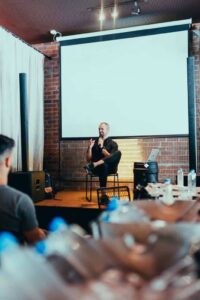
You speak all over the world, in Italy, you were just in Puerto Rico, in Shanghai. When you are doing these events, are they multi-day events, or are they a half-day, or are you speaking as a part of a larger event? Or are these your events? You mentioned a $25,000 makeover that is part of this process. Maybe just fill our listeners in, fill me in, on what it is like as an attendee.
I used to do 30 or 40 500-1500-person events a year here and I’d do it in Australia, all over. I stopped because it was taking too much of a toll. Now, I only do really interesting large groups in foreign countries because I want very badly to make a preeminent, distinct, and indelible impact on the highest performing most value-oriented entrepreneurs there. I do China two or three times a year, I do Japan once a year, I do special situations, for example in Japan, I create specialized 3-day accelerated business growth orientation using translators that have a very powerful foundational universal principles that everybody can use and we do lots of empirical exercises where hours and hours where we see that principle directly applying to their business so everybody can see the real-world application.
I do occasional 2-day for big conferences, which is what I did in Italy. The first day is all problem-solving. For Tony Robbins, I only do problem-solving and Q&A. In Beijing, we do 4 days, people pay $25,000, they come on stage for 90 minutes, they have filled out a comprehensive assessment for me, there are 300, 400, 500 people in the audience paying $5,000 to watch, and I have 90 minutes to transform meaningfully, their strategy, their business model, their marketing approach, their positioning, their whole competitive advantage. And they can get their money back if they are dissatisfied. Not being arrogant, but we’ve never had anyone want their money back. We have engineered some wild breakthroughs. But it is very intense.
In 90 minutes, through translation, you have got to be so deeply and meaningfully connected at a seminal level to the mind, what is going on, you have to perceive their environment, their competitors. You have to ask very targeted, very non-tangential questions to process, extrapolate their environment, and come out with answers that they grasp. Then you have to come up with very powerful empirical examples, case studies so they will believe. It is very exhausting but it is very stimulating.
People don't buy products or services, they buy results. Share on XThat is awesome, what a great investment for somebody to spend $25,000 to have 90 minutes of focused time to restructure your business and to watch other people have that experience too throughout that event. I remember you incorporating in one of your recent events a recording of me, we spoke about some online marketing stuff. What event was that for again?
It was for Japan. I have a very unique perspective. When I was young I think I was more arrogant and more intellectually possessive of my knowledge. I think I had a much more delusional and arrogant perception of how almighty and omnipotent I was. Today, I respect the fact that in this world there are so many profound experts, yourself being one of them, that can add so much additional insight to context and performance enhancement to an entrepreneur if the entrepreneur is connected to that expert and if someone serves as a champion advocate and asks the kind of question for appropriate answers.
And you know this, I’m kind of a savant. I’m almost a laughable mad scientist. I don’t turn my computer on, but thankfully people still use me because I know what they are trying to accomplish. I can help them, but we have to have techno-translation. What I do know is not pretend I am all-knowing at everything. I prefer to bring the best minds together and showcase them. When you are preeminent, you want what is best for the client, not for you, and I had you and I had 11 other experts, Jeff Hersburger on trust-building, John Benson on neo marketing sales letters, I had several other people who were decidedly experts on topics. I had the world’s top-most executive coach. I had the coach translate down his corporate beliefs to entrepreneurial mind shifts. But I’ll do that all the time because I want to grow.

In fact, for you, I do a series every month of high-priced, very small attendance, 10 – 20 people where I bring someone like you and I collaborate with you and we built hybrids, which is the distinction of the expert with the advocate who’s got a context of expansive understanding to pose questions and scenarios and make breakthroughs and dramatically enhance content. And you learn, I learn, the audience learns. We create things that don’t exist and they are breakthroughs. I’m obsessed at this point in my life in working with people to add value – I don’t know if that makes sense. You gain humility as you get older.
Again, that is preeminent, and it is great karma. It is a powerful way to be in the world. You have so many great testimonials. Daymond John is just raving about how you have made his extraordinary life possible. You’re a life changer and a business changer, of course, and a legacy changer. It is amazing to see. So on that note, I think we’ll finish up this conversation, it has been hugely valuable. If people want to know more about your concepts, your teachings, hire you, or go to one of your events, where would they go?
Well, we have a simple website, Abraham.com, and on it, there are 40-50 pieces of content and hours and pages of content. We also have 50 Shades of Jay, none of them even require an opt-in. We believe, now this is arrogant but again this is our position. We want to be the preemptive de facto unquestionable benefactor of entrepreneurs all over the world. And we want to invest in them with the hopes that the investment will pay off and they’ll be very happy and will be able to come back and invest in our higher-priced products and services and commercial offerings after we first help them go and prosper. There’s a ton of stuff, it is non-threatening, you don’t have to do the thing where you enter an email to see what you are getting, it is great stuff.
Many businesses grow precariously dependent on one income source. If anything happens to that one source, lots of things can go wrong. Share on XIt’s so true, it is amazing. So please, everyone check out the abraham.com website, check out 50 Shades of Jay, that’s cute. There are various other resources available there. And consider doing business with Jay. He can turn any business around or take you to a whole new level because I’ll tell you there is always another level. Even if you are wildly successful, there is always another level. So, also Jay offered some great pieces of content in this conversation, a video about preeminence, a 14-page document about the Parthenon concept, and 3 ways to grow a business, and so forth, do go to getyourselfoptimized.com to download those, and also a transcript of this episode.
I’m sure you’re going to want to refer back to it. Also with the transcript is a checklist at the end, so key concepts from this conversation, from this interview, will be distilled into this checklist. Lastly, rate and review on iTunes and also feel free to say in your review what you want to see on the show, what amazing guests you want us to cover. That would be fantastic. So thank you very much, Jay, it has been fabulous, and your time is so valuable, so thank you so much.
Well, Stephan, I want to say one thing in gratitude. Thank you so much for the privilege. My job is to reach as many deserving and needing entrepreneurs as I can but I don’t want to ignore the fact that in your own right what you do should be lauded because what you do, who you do it for, and how you do it is preeminent. And everyone I’ve talked to is unequivocally gratefully, respectful, and acknowledge the profound and very tangible and substantial impact that your work has made on their businesses and it is enormously impressive as is the books you write. I think you live a preeminent life, and I relate to it, and I’m very proud, and I hope this added value. Thank you for the privilege.
Thank you, such kind words. So everyone, thanks for tuning in, we’ll see you on the next episode of Get Yourself Optimized. My name is Stephan Spencer, your host of Get Yourself Optimized.

